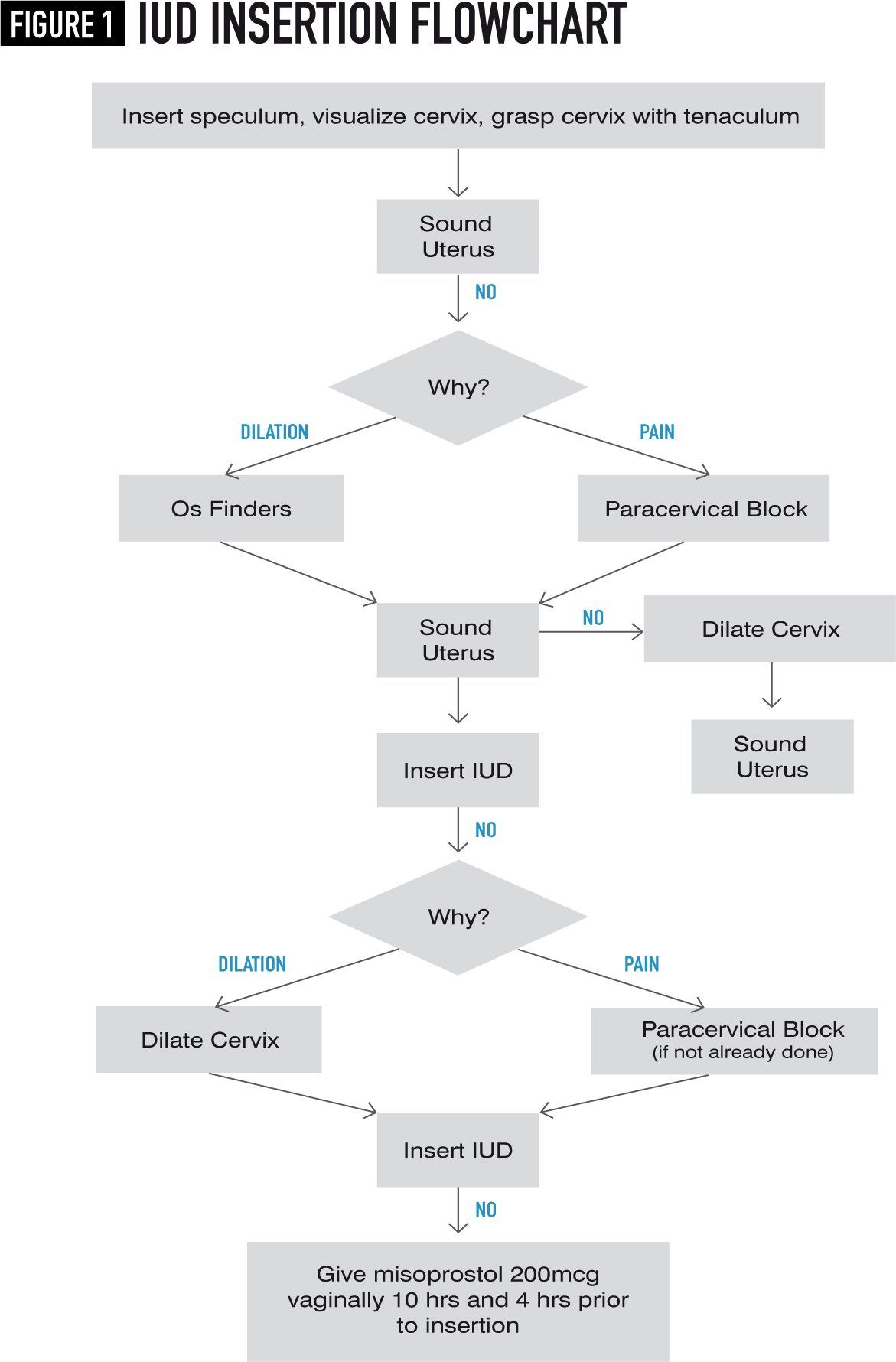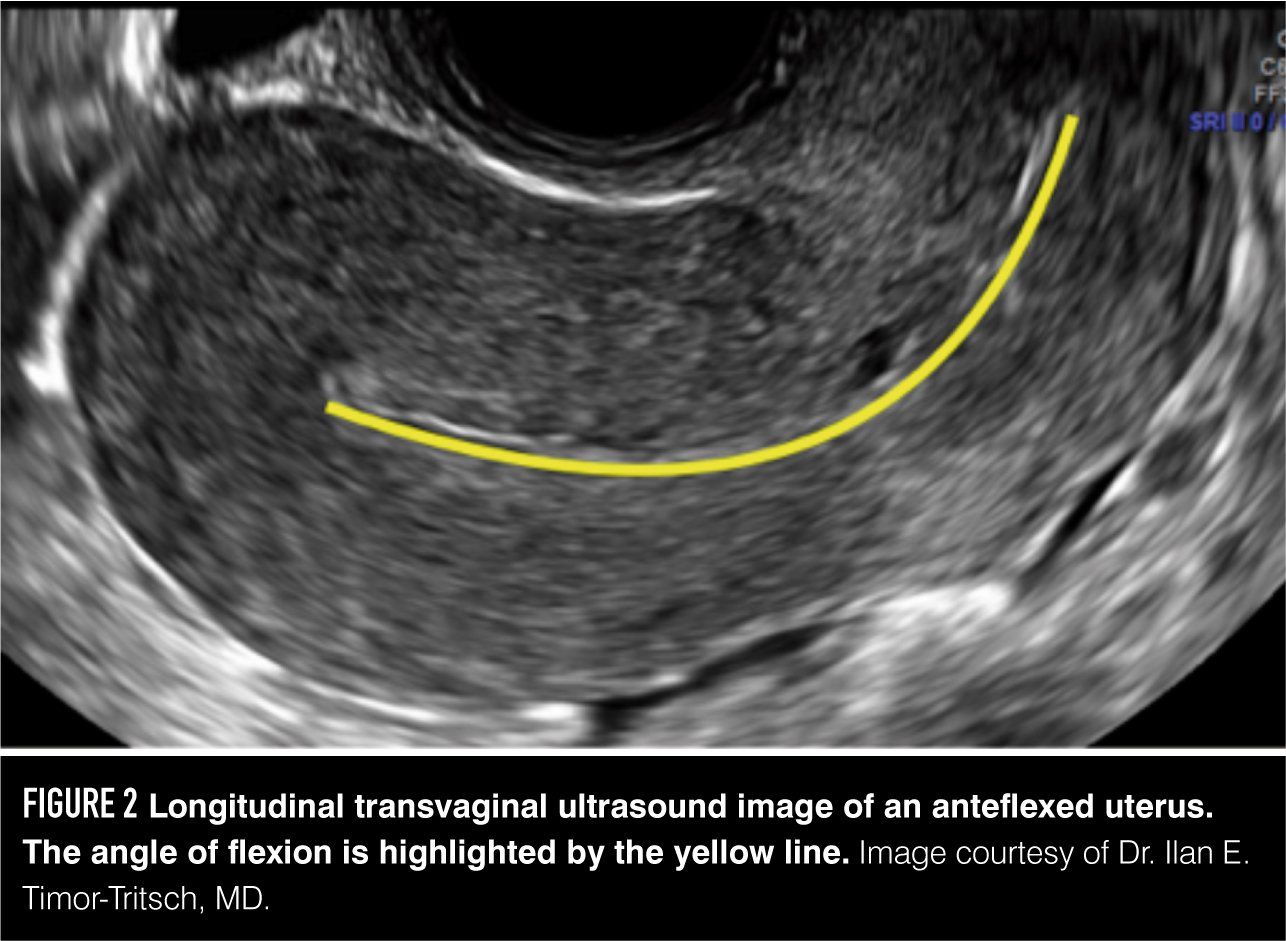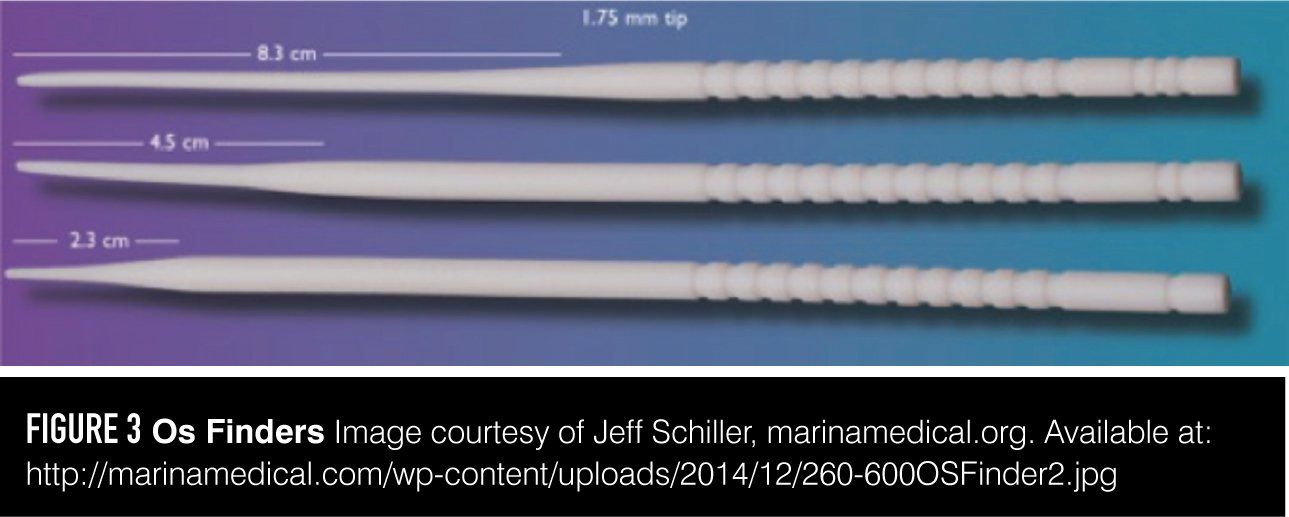Tackling the difficult IUD insertion
The goal of this article is to review these challenges and the evidence behind measures to address challenging IUD insertions.
Figure 1

Figure 2

Figure 3

Past decades have seen rates of intrauterine device (IUD) use progressively increase year over year, with 12% of women aged 15 to 44 using an IUD as of 2014, the most recent year for which data are available.1 IUD use has increased across all age, racial and ethnic groups, and with increasing demand, providers are more likely to encounter challenging insertions in their offices.
Actual rates of failed IUD insertions vary, from < 1% to as high as 18%.2 A variety of factors can influence insertion success. Parity has long been thought to be a factor, although it has not consistently been shown to be associated with increased risk of failure across studies.2-4 Other patient characteristics such as age, anxiety about the procedure, obesity, and anatomy altered by prior uterine surgery may also affect ease of insertion. Ultimately, however, clinician training and experience has the potential for the greatest impact on insertion success. Why do seasoned providers almost never fail? They are able to identify potential challenges and address them using appropriate tools. The goal of this article is to review these challenges and the evidence behind measures to address them.
Patient preparation
For many patients, the insertion process starts before they arrive at the provider’s office. Expectations are often influenced by external factors, such as the experiences of friends and family members or information gleaned from Internet searches. As such, it is important to discuss the insertion procedure to gain an understanding of the patient’s expectations and to directly address any preexisting concerns or anxieties. Some women may want to understand the details of insertion and, in these cases, explaining the steps can allay anxiety. It is also important to be realistic about the fact that cramping during certain points of insertion is normal, while also providing reassurance that it should improve once the device is in place.
Preparation for routine procedures
Several steps prior to insertion of an IUD can provide valuable information about potential challenges and set a provider on the path to success. A careful bimanual exam is critical to assess cervical and uterine position, in addition to uterine size, shape, and mobility. Appreciation of cervical position guides smooth speculum insertion, minimizing discomfort for the patient in the early stages of the process (Figure 1). An anteflexed or retroflexed uterus can make it more difficult to align the cervical canal with the uterine cavity, making passage of instruments through the internal cervical os more challenging (Figure 2). Anticipation of such potential obstacles can help a seasoned provider anticipate appropriate interventions.
In the case of an anteflexed uterus, application of suprapubic pressure by an assistant or the patient can help flatten the angle between the cervix and uterus, easing the insertion path. A sharply retroflexed uterus may invite placement of the tenaculum on the posterior, instead of the anterior, cervical lip. Regardless of the decision about where to place the tenaculum, which in the vast majority of cases should be at 12 o’clock, its use is critical to every placement. Gentle traction parallel to the floor helps straighten the cervical angle and decrease risk of perforation. For patients with an anteflexed or retroflexed uterus, greater traction may be required to improve alignment. The tenaculum also provides important counter traction, stabilizes the cervix, and provides tactile feedback while passing the internal cervical os.
When sounding the uterus and then inserting the IUD, it is helpful to hold the instrument lightly in your hand while navigating the cervical canal, until you reach the internal os. At the internal os, hold gentle steady forward pressure, while applying counter traction with the tenaculum. If the device does not pass, consider adjusting its direction, accounting for the degree of uterine flexion determined from your bimanual exam. If the device still does not pass, consider the possible reasons-for example, stenosis, resistance at the internal os, or pain-and what additional tools are available to overcome them.
Anatomical challenges
If a standard sound does not immediately pass the internal os, there are a variety of tools that may aid in successful IUD insertion. A uterine sound with a tapered tip may pass through a narrow cervical os more readily than its rounded counterpart. If sounding fails, a flexible, self-lubricating cervical os finder can be a useful tool to locate and traverse a stenotic os (Figure 3). Alternatively, small 2- to 3-mm dilators or a flexible endometrial biopsy tool are useful and readily-available alternatives for identification of the cervical canal. Once the uterine position has been determined and the cervical canal has been identified, cervical dilation is a safe addition to the IUD insertion process.
In some cases, a tortuous cervical canal, uterine fibroids, or extreme uterine flexion may compound difficulty of IUD insertion. At other times, a provider may note that the rigid sound will pass the internal os, but placement of the straighter and more flexible IUD inserter tube fails. In these cases, we find that slight over-dilation of the cervix will often ease insertion. Another adjunct is ultrasound guidance, which can be particularly useful when navigating challenging anatomy and can also demonstrate correct placement at the end of a difficult procedure.
Cervical ripening
Given the challenges presented by a stenotic cervix, it might seem that misoprostol would be a useful addition to the IUD insertion process. However, multiple studies have demonstrated that prophylactic misoprostol does not increase ease of IUD insertion.5,6 While a few studies report increased ease of insertion for nulliparous patients,7,8 the majority do not show a benefit to misoprostol use.9-11 Side effects of use include nausea and vomiting, diarrhea, and cramping; in addition, several studies actually demonstrate increased pain during IUD insertion when misoprostol is administered.10,11
Given these data, we believe that prophylactic misoprostol is contraindicated for routine IUD insertion. The exception, however, seems to be in patients who have already experienced an IUD insertion failure. In a randomized controlled trial of women attempting repeat IUD placement after a previous failure, participants who received misoprostol 200 mcg vaginally 10 hours and 4 hours before insertion demonstrated an increased rate of insertion success (87.5% vs 61.9%).4 We find that experienced providers can often place IUDs after a failure by a less-experienced colleague; using these data, however, we do use misoprostol before attempting an IUD placement after it has failed once in our own hands.
Pain management
Another common reason for difficult IUD placement is variation in patients’ pain responses during a placement attempt. Although a recent meta-analysis concluded that most interventions are unsuccessful in reducing insertional pain,12 a few have yielded promise.
Nonsteroidal anti-inflammatory drugs
Multiple studies of use of nonsteroidal anti-inflammatory drugs (NSAIDS) prior to IUD placement have produced heterogeneous results. Naproxen, when administered 1 hour before IUD insertion, shows improved pain scores compared to placebo.13 Intramuscular ketorolac decreases pain during insertion only for nulliparas, but improves discomfort for all patients at 5 and 15 minutes after placement.14 Ibuprofen in various strengths, however, has not been demonstrated to reduce pain with insertion.15,16
Lidocaine. Many different formulations of lidocaine have also been studied at time of IUD insertion with variable effect on pain scores. Evidence for the most commonly used formulation, the paracervical block, is scant; however, several trials demonstrate improved pain scores at tenaculum placement17,18 and at time of IUD insertion.18 Neither intrauterine lidocaine19 nor 2% intracervical lidocaine gel decreased insertional pain.20,21 Modalities that did improve pain scores were cervical application of EMLA cream,22 a 4% lidocaine gel applied to the cervix and instilled into the uterus,23 or three puffs of a 10% lidocaine spray.24 In our practice, we do not routinely administer lidocaine paracervical blocks due to the discomfort of the injection itself and the increased time needed for the procedure. We do, however, use this modality for patients who have a history of pain during past IUD insertion or when significant dilation or cervical manipulation is necessary.
Special Populations
Patients who have a higher anticipated pain level prior to the procedure may experience greater levels of pain during insertion,25 so those with a history of anxiety, painful past insertion attempts, or difficulty with pelvic examinations may be at particular risk for failure related to discomfort. In these cases, we find that increased anticipatory guidance and the presence of a support person to distract and calm the patient help to augment pain control. In addition, verbal support, or “verbocaine,” is a valuable tool for conscious procedures such as IUD insertion. Verbal support techniques include conversational distraction paired with calming language and positive framing (e.g. suggesting that a patient will feel “pressure” instead of “pain” at tenaculum placement).26
Adolescents are particularly at risk for declining IUD use due to anticipation of insertion pain. Additional techniques that benefit this population include use of concrete language and anatomical models or illustrations in order to demystify the process.26 Paracervical block has also been demonstrated to reduce pain significantly during and after insertion in adolescents in a recent randomized trial (median VAS score after procedure 30.0 in the lidocaine group vs. 71.5 in the sham group).27
Vasovagal events
During manipulation of the cervix, some patients may experience vasovagal reactions, characterized by nausea, diaphoresis, hypotension, bradycardia, and presyncope. Mainstays of treatment have included using the Trendelenburg position, cool packs and the smell of alcohol pads to revive a patient. In our practice, we also ask patients to contract large muscle groups, given that isometric contraction reduces venous pooling and improves circulation, thus helping to ameliorate the reaction and prevent a full syncopal episode.28 Anecdotally, patients who have a history of vasovagal reactions may benefit from placement of a paracervical block to decrease the discomfort that may precipitate such a reaction.
Conclusion
Successful IUD insertion begins with open communication, careful patient preparation, thorough physical examination, and anticipation of factors that may complicate insertion. Consistent use of a tenaculum to straighten the angle between the cervix and uterus is critical, and the availability of adjuncts such as cervical os finders and ultrasound may be helpful when passage through the internal os is difficult. Evidence demonstrates that prophylactic misoprostol should be avoided except when an insertion attempt is repeated after an initial failure by the same provider. Naproxen administration and verbal support are low-cost and efficient pain control modalities that can be employed at every insertion, and paracervical block decreases pain, particularly in adolescents, but is associated with small increases in cost and procedural time.
Disclosures:
The authors report no potential conflicts of interest with regard to this article.
References:
- Kavanaugh ML, Jerman J. Contraceptive method use in the United States: trends and characteristics between 2008, 2012 and 2014. Contraception. 2018;97(1):14-21.
- Dermish AI, Turok DK, Jacobson JC, Flores ME, McFadden M, Burke K. Failed IUD insertions in community practice: an under-recognized problem? Contraception. 2013;87(2):182-186.
- Teal SB, Romer SE, Goldthwaite LM, Peters MG, Kaplan DW, Sheeder J. Insertion characteristics of intrauterine devices in adolescents and young women: success, ancillary measures, and complications. Am J Obstet Gynecol. 2015;213(4):515.e1-5
- Bahamondes MV, Hidalgo MM, Bahamondes L, Monteiro I. Ease of insertion and clinical performance of the levonorgestrel-releasing intrauterine system in nulligravidas. Contraception. 2011;84(5):e11-6
- Heikinheimo O, Inki P, Kunz M, et al. Double-blind, randomized, placebo controlled study on the effect of misoprostol on ease of consecutive insertion of the levonorgestrel-releasing intrauterine system. Contraception. 2010;81(6):481–486.
- Dijkhuizen K, Dekkers OM, Holleboom CA, et al. Vaginal misoprostol prior to insertion of an intrauterine device: an RCT. Hum Reprod. 2011;26(2):323–329.
- Sääv I, Aronsson A, Marions L, Stephansson O, Gemzell-Danielsson K. Cervical priming with sublingual misoprostol Interventions for pain with intrauterine device insertion prior to insertion of an intrauterine device in nulliparous women: a randomized controlled trial. Hum Reprod. 2007;22(10):2647–2652.
- Scavuzzi A, Souza AS, Costa AA, Amorim MM. Misoprostol prior to inserting an intrauterine device in nulligravidas: a randomized clinical trial. Hum Reprod. 2013;28(8): 2118–2125.
- Espey E, Singh RH, Leeman L, Ogburn T, Fowler K, Greene H. Misoprostol for intrauterine device insertion in nulliparous women: A randomized controlled trial. Am J Obst Gynecol. 2014;210(3):208.e1–5.
- Lathrop E, Haddad L, McWhorter CP, Goedken P. Self-administration of misoprostol prior to intrauterine device insertion among nulliparous women: a randomized controlled trial. Contraception. 2013;88(6):725–729.
- Edelman AB, Schaefer E, Olson A, et al. Effects of prophylactic misoprostol administration prior to intrauterine device insertion in nulliparous women. Contraception. 2011;84(3):234–239.
- Lopez LM, Bernholc A, Zeng Y, et al. Interventions for pain with intrauterine device insertion. Cochrane Database Syst Rev 2015;7:CD007373.
- Karabayirli S, Ayrim AA, Muslu B. Comparison of the analgesic effects of oral tramadol and naproxen sodium on pain relief during IUD insertion. J Minim Invasive Gynecol. 2012;19(5):581–584.
- Ngo LL, Ward KK, Mody SK. Ketorolac for pain control with intrauterine device placement: a randomized controlled trial. Obstet Gynecol. 2015;126(1):29-36.
- Bednarek PH, Creinin MD, Reeves MF, Cwiak C, Espey E, Jensen JT. Prophylactic ibuprofen does not improve pain with IUD insertion: a randomized trial. Contraception. 2015;91(3):193–197.
- Chor J, Bregand-White J, Golobof A, Harwood B, Cowett A. Ibuprofen prophylaxis for levonorgestrel-releasing intrauterine system insertion: A randomized controlled trial. Contraception. 2012;85(6):558–562.
- Mody SK, Kiley J, Rademaker A, Gawron L, Stika C, Hammond C. Pain control for intrauterine device insertion: A randomized trial of 1% lidocaine paracervical block. Contraception. 2012;86(6):704–709
- Cirik DA, Taskin EF, Tuglu A, Ortaç AS, Dai O. Paracervical block with 1% lidocaine for pain control during intrauterine device insertion: a prospective, single-blinded, controlled study. Int J Reprod Contracept Obst Gynecol. 2013;2(3):263–267.
- Nelson AL, Fong JK. Intrauterine infusion of lidocaine does not reduce pain scores during IUD insertion. Contraception. 2013;88(1):37–40.
- Allen RH, Raker C, Goyal V. Higher dose cervical 2% lidocaine gel for IUD insertion: A randomized controlled trial. Contraception. 2013; 88(6):730–736.
- Maguire K, Davis A, Rosario Tejeda L, Westhoff C. Intracervical lidocaine gel for intrauterine device insertion: a randomized controlled trial. Contraception. 2012;86(3):214–219.
- Ahmadi Doulabi M, Tavakolian S, Mortazavi A, Akbarzade Baghban A. Effect of EMLA cream on pain of Copper IUD insertion [article in Persian]. Sci J Hamadan Nurs Midwif Fac. 2013;21(3):24–30.
- Tornblom-Paulander S, TingÃ¥ker BK, Werner A, et al. Novel topical formulation of lidocaine provides significant pain relief for intrauterine device insertion: pharmacokinetic evaluation and randomized placebo-controlled trial. Fertil Steril. 2015;103(2):422–427.
- Aksoy H, Aksoy Ã, Ozyurt S, Açmaz G, Babayigit M. Lidocaine 10% spray to the cervix reduces pain during intrauterine device insertion: a double-blind randomised controlled trial. J Fam Plann Reprod Health Care. 2016;42(2):83-87.
- Dina B, Peipert LJ, Zhao Q, Peipert JF. Anticipated pain as a predictor of discomfort with intrauterine device placement. Am J Obstet Gynecol. 2018 Feb;218(2):236.e1-236.e9.
- Hillard PJ. Practical tips for intrauterine devices use in adolescents. J Adolesc Health. 2013;52(4 Suppl):S40-46.
- Akers AY, Steinway C, Sonalkar S, et al. Reducing Pain During Intrauterine Device Insertion: A Randomized Controlled Trial in Adolescents and Young Women. Obstet Gynecol. 2017;130(4):795-802.
- Coffin T, Raj S. Non-Invasive Management of Vasovagal Syncope. Auton Neurosci. 2014;184:27-32.
